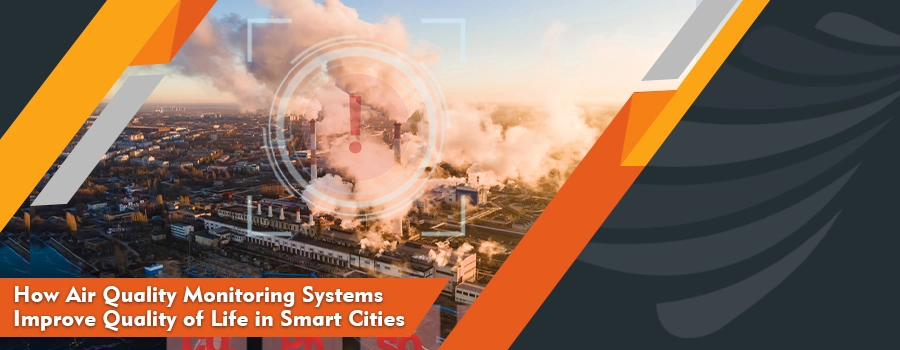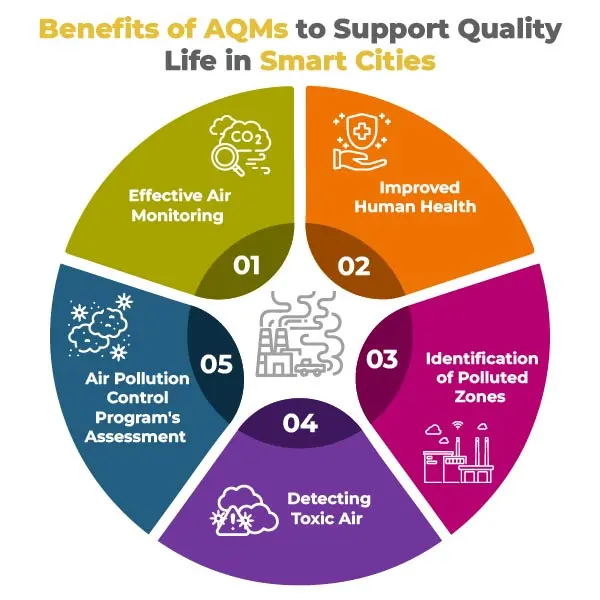When we hear the word ‘Smart City,’ we always picture a place that is not only technologically advanced or futuristic but also a standard place for humans to live without compromising the environment. A smart city needs to be clean from all kinds of pollution, be it air pollution, water pollution, or land pollution. The smart city concept complies with advanced technology, and many renowned technologies are used to resolve problems like air pollution and make the air fresh for the residents to breathe.
But the question is, does it matter to have air quality monitoring systems in smart cities for clean air? Before answering that, we must highlight the health impacts that air pollution can have on humans. The research by WHO revealed that 90% of the people on earth breathe deteriorating air quality. Bad air quality adversely impacts human health and increases respiratory diseases, leading to several casualties every year. Air quality monitoring becomes essential to ensure that no life in a smart city is exposed to the health risk caused by air pollution.
The following article emphasizes the need for air quality monitoring in smart cities while highlighting its potential benefits.
Why do we need Air Quality Monitoring in Smart Cities?
Urban areas are densely populated and ensuring a safe and healthy environment for these highly populated areas is crucial. Government authorities and other regulatory bodies associated with the environment play an essential role in safeguarding the citizen’s interests. The government prioritizes monitoring the air quality and reducing pollution to provide fresh air for citizens to breathe. Most deaths due to air pollution occur in low- and middle-income countries. This is because these developing countries do not have enough resources to access the data on air quality.
With increasing air pollution, the health risk of respiratory diseases is also increasing. To tackle this challenge beforehand, governments all around the globe have integrated a cost-effective solution, namely, Air Quality Monitoring (AQM), to make the cities smarter and cleaner than ever before. Most AQMs utilize sensor-based technologies like IoT and Artificial Intelligence to collect and analyze the data on air pollution levels. The system can use historical information on pollutant levels and send the forecast read of air pollutants, traffic, temperature, and weather so that government can take data-driven actions to control air pollution. Combating air pollution has made AQMs an integral part of smart cities.
Benefits of AQMs to Support Quality Life in Smart Cities
1. Effective Air Monitoring
One of the most important steps in combating air pollution in a smart city is to set up an AQM, which has the ability to detect various air quality parameters accurately in real time. With efficient AQMs in place, there is no need to ambiguously guess the dust levels, smoke, and harmful particles in the air. AQMs collect data that will indicate the status of current air quality in smart city and compares it to the suitable levels of air quality that should be maintained to provide fresh air to the citizens. Effective data collection and analysis in this regard can help the government practice measures to control air pollution. For instance, if the AQM indicates high levels of Co2 in the air, the government can offer residents low-carbon transport options, etc., to control Co2 emissions.
2. Improved Human Health
The availability of clean air is essential for living and also improves the quality of life. People breathing polluted air in urban areas are at high risk of diseases as human health is affected by the increased particulate matter in the air. Until and unless the authorities can check the air quality in urban areas, people cannot get aware of what kind of polluted air they breathe, which also adversely impacts their health. IoT-enabled air quality monitoring systems in a smart city can help the government combat air pollution and ensure a healthy environment for the residents. AQMs consist of gateways, and a network of sensors placed in the smart city provides a data-driven approach to monitoring air quality. The system generates an alert whenever toxic components or pollutants are found in the air so that authorities can take necessary actions when required.
3. Identification of Polluted Zones
The presence of particulate matter in the air varies from place to place because of weather, altitude, traffic conditions, and population changes. For instance, the air in a specific area might seem more polluted because of the increased traffic. AQMs offer real-time air quality data monitoring to identify air pollution trends in different areas of the city.
AQMs in smart cities help the authorities to get geographically relevant data to monitor air pollution levels. This shows the areas where air pollution levels are highly concentrated and influence the authorities to prioritize these areas and make them pollution free. Hence, it can be said that the AQMs can help locate pollution hot zones in smart cities and ensure that no polluted area gets unnoticed.
4. Detecting Toxic Air
IoT-enabled air quality monitoring systems in smart cities are highly functional and can detect the presence of toxic air both in open and closed environments. There can be a lot of incidents due to which toxic gases might spread into the city’s atmosphere. For instance, a fire may break out in the city, increasing the contents of smoke particles in the air. The AQMs equipped in a city can detect the changes in pollutant levels in the air, like smoke and other hazardous particles, and instantly alert the authorities to take necessary actions. Hence, using AQM in a smart city can reduce the chances of gas explosions, fire hazards, and other naturally occurring calamities by continuously monitoring the air quality in the region and preparing the authorities for emergency response.
5. Air Pollution Control Program’s Assessment
The focus of Smart Cities is to save lives and improve the living conditions for the residents. In this regard, the government develops and implements many pollution-related policies in cities. However, there is a need to frequently check whether the implemented policies or programs are generating the desired results. For instance, AQMs can help officials evaluate their own air pollution control programs to see whether the levels of air pollutants have been reduced. In this way, the government can identify the steps or activities of the air pollution control programs that have positively impacted the environment of the smart city and continue to implement them with greater effectiveness. This can further help devise new strategies for future air pollution control programs and obtain practical and realistic data to test those programs.
In a Nutshell…
Smart cities’ standard of quality life demands fresh and clean air to provide health benefits to the residents and enhance environmental effectiveness. In this regard, an air quality monitoring system has proven effective because this IoT-enabled smart device can detect the pollutants and toxic components in the city’s air. To conclude, it can be said that AQMs are the ultimate resources to combat air pollution and help the authorities take necessary data-driven actions to maintain optimal air quality levels in smart cities.






